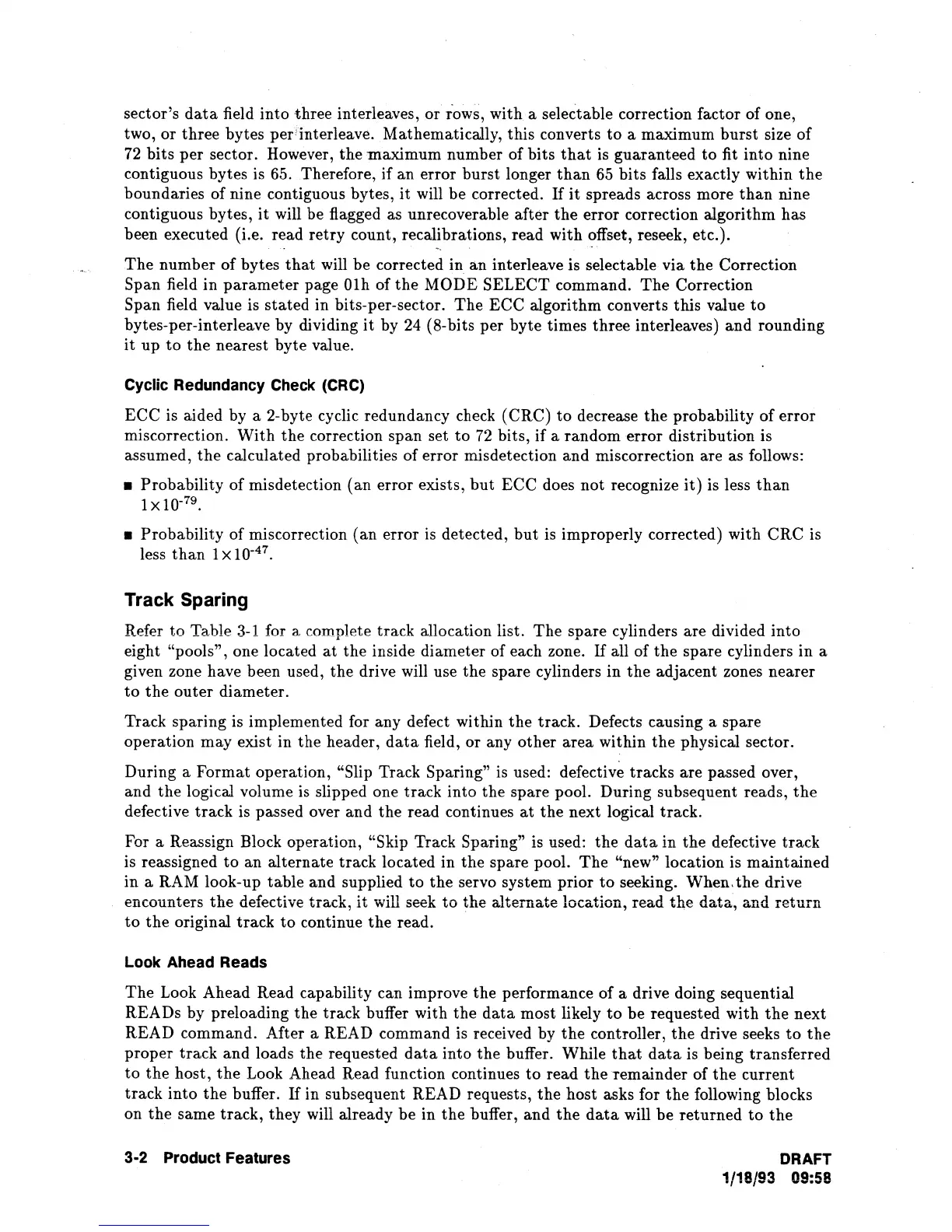sector's
data
field
into
three interleaves, or rows, with a selectable correction factor of one,
two,
or
three
bytes per'interleave. Mathematically, this converts to a maximum
burst
size
of
72
bits
per
sector. However,
the
maximum number of bits
that
is guaranteed
to
fit
into
nine
contiguous bytes is 65. Therefore,
if
an error
burst
longer
than
65
bits falls exactly within
the
boundaries of nine contiguous bytes,
it
will be corrected.
If
it
spreads across more
than
nine
contiguous bytes,
it
will be flagged as unrecoverable after
the
error correction algorithm has
been executed (Le. read
retry
count, recalibrations, read with offset, reseek, etc.).
.
'.
The
number
of
bytes
that
will
be
corrected in an interleave is selectable via
the
Correction
Span field
in
parameter
page 01h
of
the
MODE
SELECT
command.
The
Correction
Span field value is
stated
in bits-per-sector.
The
ECC
algorithm converts this value
to
bytes-per-interleave by dividing
it
by 24 (8-bits per byte times
three
interleaves)
and
rounding
it
up
to
the
nearest
byte
value.
Cyclic Redundancy Check (CRC)
ECC
is aided by a 2-byte cyclic redundancy check (CRC)
to
decrease
the
probability
of
error
miscorrection.
With
the
correction span set
to
72
bits,
if
a
random
error distribution is
assumed,
the
calculated probabilities of error misdetection
and
miscorrection are as follows:
• Probability
of
misdetection (an error exists,
but
ECC does
not
recognize
it)
is less
than
1 x
10-
79
.
• Probability
of
miscorrection
(an
error
is
detected,
but
is improperly corrected) with
CRC
is
less
than
1 x
10-
47
.
Track Sparing
Refer
ta
Table
3-1
far a complete track allocation list.
The
spare cylinders are divided
into
eight "pools", one located
at
the
inside diameter of each zone.
If
all of
the
spare cylinders in a
given zone have been used, the drive will use
the
spare cylinders
in
the
adjacent zones
nearer
to
the
outer
diameter.
Track sparing is implemented for any defect within
the
track. Defects causing a spare
operation
may
exist in
the
header,
data
field,
or
any
other
area
within
the
physical sector.
During a
Format
operation, "Slip Track Sparing" is used: defective tracks are passed over,
and
the
logical volume is slipped one
track
into
the
spare pool. During subsequent reads,
the
defective
track
is passed over
and
the
read continues
at
the
next logical track.
For a Reassign Block operation,
"Skip Track Sparing" is used:
the
data
in
the
defective
track
is reassigned
to
an
alternate track located in
the
spare pool.
The
"new" location is maintained
in
a RAM look-up
table
and
supplied
to
the
servo system prior
to
seeking. When.
the
drive
encounters
the
defective track,
it
will seek
to
the
alternate
location, read
the
data,
and
return
to
the
original
track
to
continue
the
read.
Look Ahead Reads
The
Look Ahead Read capability can improve
the
performance
of
a drive doing sequential
READs by preloading the
track
buffer with
the
data
most
likely
to
be requested with
the
next
READ command. After a READ command is received by
the
controller,
the
drive seeks
to
the
proper
track
and
loads
the
requested
data
into
the
buffer. While
that
data
is being transferred
to
the
host,
the
Look Ahead Read function continues
to
read
the
remainder of
the
current
track
into
the
buffer.
If
in subsequent READ requests,
the
host asks for
the
following blocks
on
the
same
track,
they will already be in
the
buffer,
and
the
data
will be
returned
to
the
3·2 Product Features
DRAFT
1/18/93 09:58
